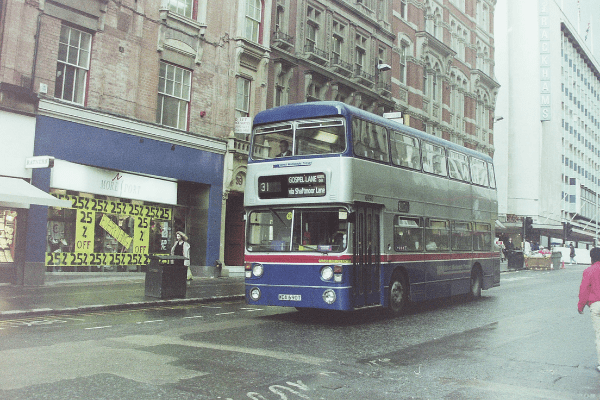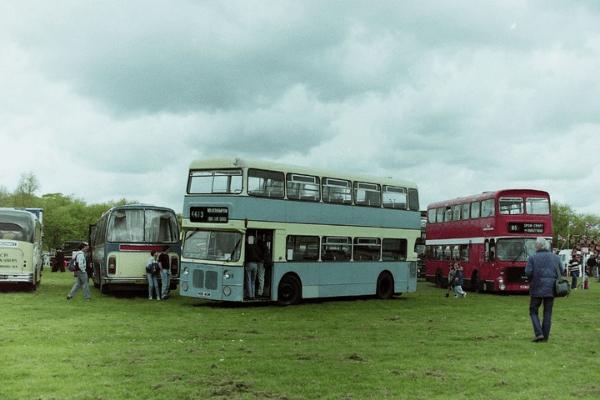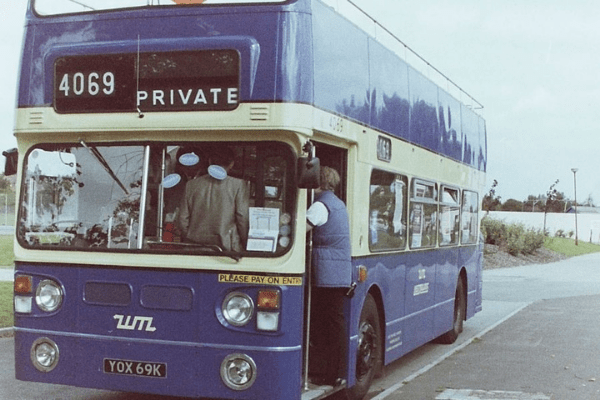
West Midlands Fleetlines at fifty
Part 4 by Mark Fitchew
Published: 15th December 2021
Part four - Fleetlines and The Bristol VR bus
And so Park Royal bodied 6690 would be the last WMPTE Standard Fleetline to enter service, from Acocks Green garage in May 1979, with MCW Metrobuses now taking their place as the PTE’s standard double decker. But 6690 would not be the last Fleetline to enter service with the PTE!
DMS
The PTE was proceeding well with replacing the remaining stock acquired from the fleets it absorbed but there was a problem with a batch of buses that had entered service in the very early days of the PTE. This was the “Jumbo” Park Royal bodied thirty three foot Fleetlines originally ordered by BCT (those ordered by Wolverhampton weren’t such a problem, probably due to a slightly less arduous life!) which had been showing signs of wear on their long bodies (it was early concern about this that persuaded the PTE to standardise on the thirty foot long Fleetline) so it was decided that these would have to be withdrawn prematurely. Fortunately, Essex based vehicle dealer Ensign came up with a solution! For they had been appointed the dealer for onward sale of London Transport’s DMS class Fleetlines, of which London Transport bought some 2000 in the seventies........ and then decided it didn’t like them! Therefore, a deal was done with Ensign, who would convert, if desired, from dual door to single door, and sell on to other operators who were hungry for decent, middle aged buses, including WMPTE, with whom Ensign even threw in an exchange deal for surviving Jumbos, which would be sold onto various Independents, two of these are now preserved, with 3913 having recently changed hands and 3997 now part of the NXWM Heritage fleet.
WMPTE would purchase eighty DMSs, dating from 1972/1973, all of which would feature Metro Cammell bodywork and Gardner engines (Park Royal would also build DMS bodies, whilst Leyland engines also featured in the class) all converted to single door and numbered 5500-5580, with a gap to contain ex BCT rebodied Fleetline 5531. They would not directly replace Jumbos, although the first twenty (5500 -5519) would be allocated to the Jumbo stronghold of Selly Oak, whose whole double deck fleet had consisted of the marque, the replacement of which had began in 1979, with the first of the production batch of Metrobuses, plus the transfer of several older ex BCT Fleetlines displaced by the last new Fleetlines elsewhere. Temporarily, a selection of ex Coventry Fleetlines would also help out at the garage, before the Metrobuses and DMSs began to arrive.
The remaining DMS would be allocated to three other South Division garages, Harborne (5520-5530/5532-5540), Yardley Wood {5541-5560) and Quinton (5561-5580.) The PTE would replace the class’s automatic gears with the semi automatic boxes fitted in the PTE Standard models but the DMSs power steering would remain, in contrast to the non powered steering specified by ultra conservative PTE engineers, which would henceforth be compared unfavourably with not only the DMS steering but also that of the MCW Metrobuses entering the fleet in ever increasing numbers.
The DMSs would have a reasonable life with the PTE, though withdrawals would begin in 1983, concurrent with similarly aged PTE Standard Fleetlines, with Selly Oak and Harborne having lost all their examples by 1985. In contrast, Yardley Wood would convert two of their examples, 5546 and 5552, to feature standard PTE blinds, though lack of space meant that only a three track number blind could be fitted.
The final three, 5533/5534 (transferred from Harborne – Yardley Wood when the former garage lost their allocation) and Quinton 5574, would last until October 1986, with 5574 ceasing service on Friday 24th October.

Bristol VRs
The 200 Metro Cammell bodied Bristol VRs had continued their lives at Walsall and the two Wolverhampton garages reflectively successfully, but, after 4343-4373 had been put through the PTE’s Mid Life Overhaul programme, it was felt that the cost of the work required in getting these buses through this procedure wasn’t worthwhile, (impending service cuts would also encourage this economy) so these ceased on 4374 onwards, so the relevant buses were stored upon expiry of their certificate of fitness, with several examples sold to National Bus Company subsidiary National Welsh. Most of the second batch, however, would receive a mid life overhaul.
From 1983, the remaining VRs would be concentrated at Walsall, where the drivers union found the steering on these to be preferable to the non power steered Fleetlines, which were subsequently blacked by the garage’s Union representatives. This lead to Walsall becoming the first garage to lose it’s allocation of Fleetlines. The overhauled members of the first batch would soldier on alongside the second batch, operating alongside Walsall’s growing allocation of Metrobuses. Reliability would become an issue, with withdrawals of the worst examples taking place where possible, something that was helped by the allocation of the closing Oldbury garage’s fleet of thirty five Volvo Ailsas to Walsall in January 1986.
The last VR to be overhauled would be 4714, a former Wolverhampton allocated example that spent a considerable time in works, not returning to service until December 1984, long after all surviving examples had transferred to Walsall, where 4714 would join them, decked out in a representation of the former South Staffordshire Tramways livery of cream and brown to celebrate 100 years of public transport in Walsall. Today, it is preserved at the Aston Manor Transport Museum, now based within 4714’s old home territory in Aldridge, reviving happy memories for me when it operates the museum’s free bus services around the area. Also preserved is first batch 4413, one of those that were sold to National Welsh, which can be found frequently working bus services at Wythall Transport Museum.
The VRs would soldier on until deregulation in October 1986, with those final months even seeing two, 4640 and 4725, spending a short period on loan to Dudley! Deregulation would see the type withdrawn from service, with many subsequently finding second homes with various operators.

Fleetline Developments
Leyland would cease production of the Fleetline in 1980, with the final example being an ECW bodied bus for the independent South Notts, so it was a good job that the PTE had decided to standardise on the Metrobus before this!
1980 would also see the Leyland engine Fleetlines at Dudley swapped for Gardner engine examples from the South Division. The Leyland engines had proved to be impressively powerful in climbing Dudley’s steep hills, but this performance produced very heavy fuel consumption, which a PTE seeking economies felt justified the exchange with the more economical Gardners. The thirsty nature of the Leyland 680s had lead Walsall based Fleetline 6338 to have it’s 680 replaced with a Gardner in January 1979. The success of this conversion would lead to the conversion of all the Leyland engine Fleetlines with Gardners from withdrawn older Fleetlines over the coming years, with Perry Barr’s 4548 being the last to receive a Gardner, as late as 1985.
Metrobuses would continue replacing the remaining buses that had been inherited from acquired operators, with most of these survivors being Fleetlines by this time. In order to balance the age profiles of the various garages, several of the early, yellow celling PTE Fleetlines were transferred around. 1979 would see four of these, ex Walsall 4051-4054, would spend a brief spell at Coventry before heading to Birmingham’s Coventry Road. The early eighties would see other examples head to ex Midland Red garages to replace the last D13 Alexander bodied Fleetlines. With the exception of the latter ex Coventry East Lancs bodied Fleetlines, all the remaining acquired stock would be withdrawn in 1983, from which time, those early PTE Standard Fleetlines themselves would begin normal withdrawals.
The Decline Begins
As previously mentioned, the PTE Standard Fleetlines had been ordered to a very basic specification cab wise, with the model’s non powered steering being compared unfavourably with that fitted in most other models in the fleet, such as DMSs, Bristol VRs, Volvo Ailsas, Leyland Nationals and, in particular , the ever growing number of MCW Metrobuses, with the PTE being the first operator to standardise on the MK 2 variant, with 2436, from 1982 onwards. Therefore, doubtless with the encouragement of the Trade Unions, the new Metrobuses would be used most intensively, taking over most evening and Sunday operation from most garages, as the eighties progressed. In particular, the yellow ceiling Fleetlines would be withdrawn between 1983 and 1985, with just one survivor, Park Lane’s 4041, surviving into 1986, as a celebrity vehicle-ex Walsall Northern Counties Fleetline 116L and ex West Bromwich Metro Cammell Fleetline 101H would also survive as celebraties, but with the commercial pressures of deregulation on the way, all three buses would be withdrawn, with 116L and 101H passing to Wythall Transport Museum (where both are part of the running fleet today) whilst 4041 would ultimately pass to the Aston Manor Transport Museum (at the moment, it’s sadly off the road.)
Another yellow ceillinged Fleetline earning a reprieve was 4069, which was converted to open top in 1985, joining earlier conversion 3867, an ex BCT Fleetline.
Oldbury would become the second garage to lose it’s Fleetline allocation, following the arrival of ten Leyland National 2s following the closure of Stourbridge on 26th January 1985. Oldbury had actually been the last PTE garage to receive a Metrobus allocation, first receiving some in the summer of 1983, but the main buses at this small, Black Country garage were Volvo Ailsas, with five being added to it’s original allocation of thirty following the closure of Sutton Coldfield in 1984. As mentioned in the VR section, these thirty five would transfer to Walsall upon Oldbury’s closure on 25th January 1986 but deregulation would see them join the other fifteen ex Sutton Ailsas at Perry Barr, where they would all remain until sold to London Buses in the summer of 1987.
Following the demise of the yellow ceiling Fleetlines, withdrawals would commence on the 4243-4342 batch of Fleetlines.

Autosteer
As the Metrobus became increasingly dominant in the fleet, that model’s power steering and air brakes made it seem incredibly superior to the non power steered Fleetlines. Despite the withdrawal of many early Fleetlines, it was expected that many of the latter examples would be around into the nineties, so it was decided to upgrade those latter Fleetlines with Autosteer power steering and Webasto cab heaters, in the hope that this would make the Fleetlines more attractive to drivers who were getting used to the creature comforts of the Metrobus cabs! To this end, the cab seats would also be fitted with moquette, in place of the previous PVC. Buses from 6301 onwards were eligible for the modifications, which commenced in 1985. A clear recognition point was the replacement of the two small radiator grilles beneath the windscreen with a blank space, which soon featured a West Midlands fleetname transfer applied to this space.
Unfortunately, the Autosteer would prove to be not the smoothest of power steering systems, being incredibly sensitive, which meant much adjustment of steering needed to take place, with many drivers actually preferring the unmodified Fleetlines. So driver preference for Metrobuses would largely continue, with Fleetlines being swapped for the newer model whenever possible.
Deregulation
The 1985 Transport Act paved the way for the deregulation of the British Bus Industry (outside London and Northern Ireland) which would begin on Sunday 26th October 1986. The PTE would have to separate it’s bus operation to a separate company, West Midlands Travel (WMT) which at this point, was owned by the seven West Midlands Metropolitan councils, which also took over the PTE itself, the West Midlands County Council being abolished in April 1986. The PTE would continue to be involved in subsidising rail services, funding senior citizen and disabled concessionary travel and providing bus services not covered by the new commercial network, these being put out to tender for competing operators to bid for. Therefore, WMT (the company having been set up on 1st January 1986, to prepare the way for D-day) would find itself having to register the commercial services it intended to operate from 26th October, by April.
The new company decided that those Fleetlines which were to survive it’s way into the new era, would feature the lighter blue as used on the Metrobuses, though this would continue to be applied in the existing Fleetline style, with blue featuring below the lower deck, in contrast the larger covering of blue featuring on the Metrobuses. Quinton’s 6572 would be the first to receive this, with further examples being repainted throughout the summer of 1986. These would enter service minus the PTE fleetnames, with the new West Midlands Travel fleetname appearing on these as the fateful date approached.
As it had to pay it’s way, the commercial network would be considerably smaller than the PTE network that it was replacing, so a large number of the eldest buses would be leaving the fleet. So on the way out were the remaining Bristol VRs, the ex Coventry East Lancs bodied Fleetlines, as well as the 44xx East Lancs Fleetlines ordered by Coventry but delivered to the PTE (the latter 67xx East Lancs Fleetlines would survive) and all PTE Standard Fleetlines below 6301 (though several 45xx and 46xx would survive into the new era for a short period)
So Fleetline numbers would be substantially reduced.
We would like to thank Mark Fitchew, a very knowledgeable bus enthusiast and bus driver for the help with putting this blog series together. Keep your eyes open for the final part of this blog series, which will be published very soon!
Read more from explore
Like us on Facebook
See what we're up to, what's going on locally and get the latest service updates.
Like us on Facebook
Follow us on X
The best place to see the latest West Midlands travel updates while on the go.
Follow us on XGet inspired on Instagram
See local sights and tag us in your bus pictures. Follow us to get involved!
Follow our InstagramBack to top





